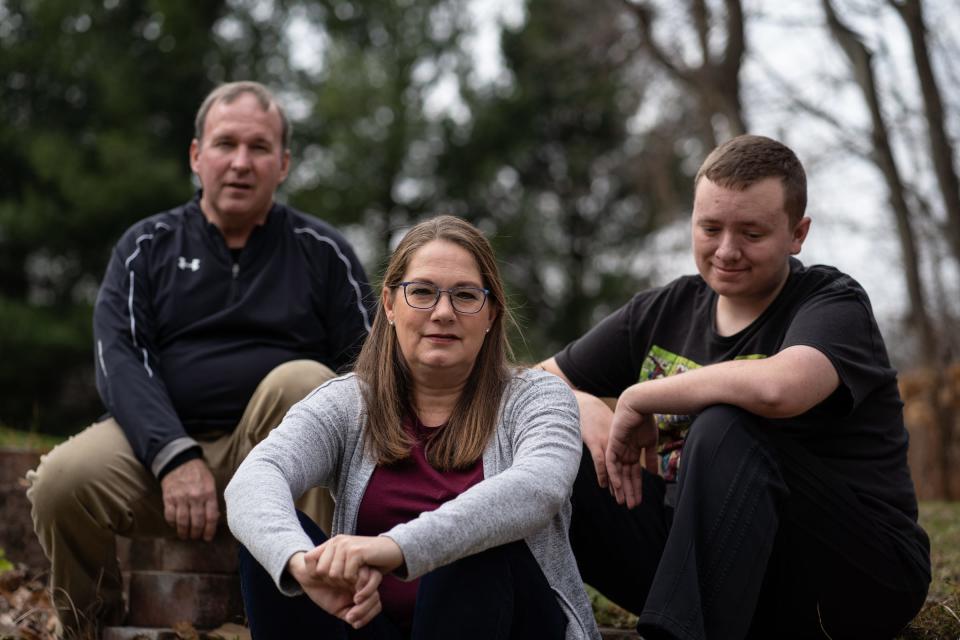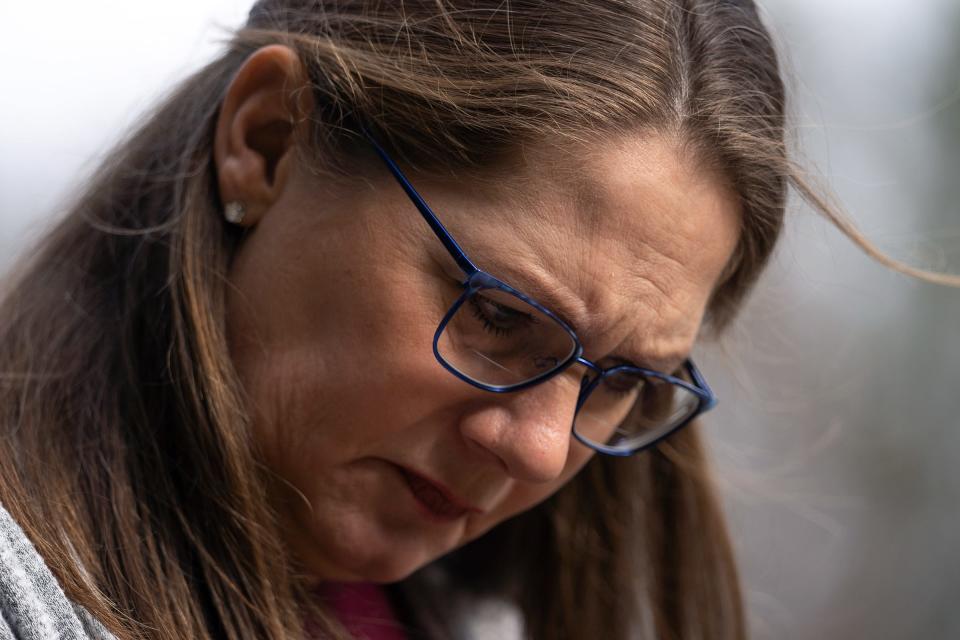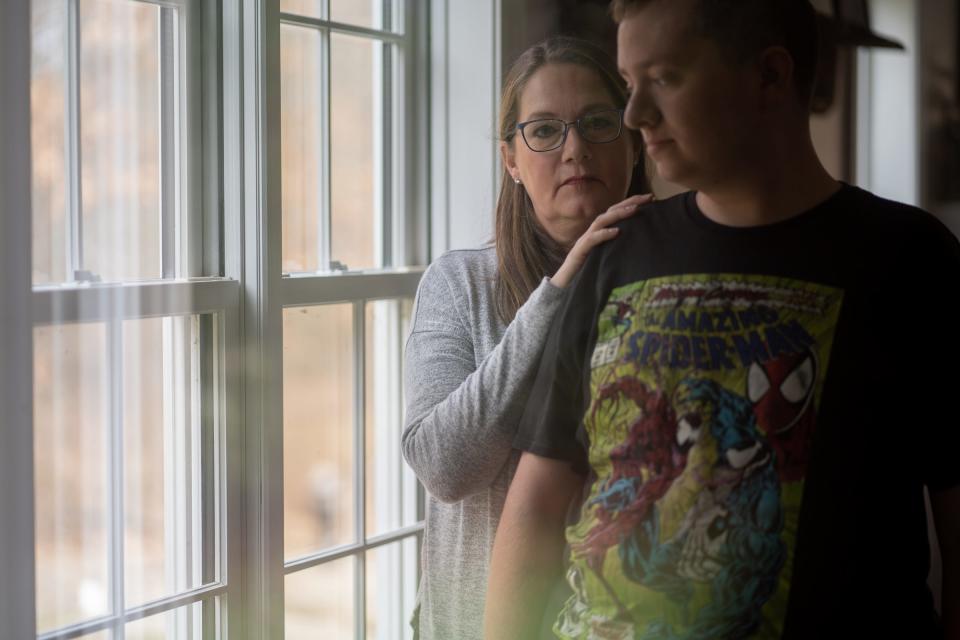'I'm scared. Are you scared?' A Michigan mom's harrowing story of leaving her son with autism to fight COVID-19 alone in the hospital
- Oops!Something went wrong.Please try again later.
DETROIT – In the emergency room of Sparrow Hospital in Lansing, Michigan, Pam Warfle begged for compassion.
Her son with autism had COVID-19 and needed to be hospitalized, but the staff informed her she couldn't stay.
"'You don't understand. You're going to have to carry me out of here. He cannot communicate,'" Warfle recalled telling the doctors and nurses. " 'You can put me in bubble wrap. I'll stay in a corner.' "
The hospital wouldn't bend: "We cannot do it," they said.
In that moment, her son Jonathan, 21, who has always lived with his parents and attends life skills classes, became her hero.
“He looked at me and said, ‘Mom, It'll be OK,’ ” Warfle recalled. “I told him, ‘I'm scared. Are you scared?’ He said, ‘Mom, I gotta get better.’ ”
With an ache in her heart and tears in her eyes, she gave him a hug and a kiss, slid his tray of water and ice chips over to him, and left.

Three days later, Warfle, was back at the same ER, this time with her 83-year-old mother.
Leona Smith – a feisty, retired factory worker who hadn't been hospitalized since her knee replacement two decades ago – also had COVID-19 and was struggling to breathe. She lives with her daughter's family in Perry and presumably picked up the virus from her grandson, Warfle said.
Mapping coronavirus: Tracking the outbreak, state by state
Unlike her grandson, Smith has COPD (chronic obstructive pulmonary disease), an inflammatory lung disease that causes obstructed airflow.
Warfle knew she would have to leave her mom at the hospital and advocate from the outside.
"She did not want to go in," Warfle recalled. “She had convinced me she was just tired. She said, 'Pam, I just need to sleep. We can go in the morning.' "
But Warfle didn't take any chances. She packed her mother's bags and her mini oxygen tank, got her in the car and had her 20-year-old daughter, Arena, drive them to the hospital.
It was around 7 p.m. Nov. 9 when they pulled up to the ER with Leona. Warfle carefully maneuvered her mother out of the car, held her up and the two walked arm-in-arm for about 40 feet when a security guard spotted them and asked whether they needed a wheelchair.
"She has COVID," Warfle told the guard.
"'You won't be able to come in, ma'am,'" she recalled him telling her.

With Jonathan, she at least got to go into the ER. This time, she had to leave her mom at the door. As hospital staff wheeled her inside the building, Warfle hollered from afar, "She has her medicine list in her front pocket, with my phone number. And her oxygen tank is only half full."
As she got back in the car, pain and sadness set in.
In the hospital, nurses struggled to draw Jonathan's blood, poking him so many times that they had to call his mom in the middle of the night to keep him calm and talk him through it. He was fighting a virus that had crept into his lungs and wiped him out so badly that he could barely talk.
"It was so hard because all I could do was think of Jonathan," Warfle said. "I'm so close to him, and I had to turn around and leave him again."
For three weeks, the virus gripped Warfle in fear and anxiety. She sobbed. She prayed. She broke down.
"There were times in the middle of the night of me crying out loud in my front yard," she said, "crying out to God and asking for help and praying that his will be done."
'Stay away from Grandma'
The Warfles live in a 3,000-square-foot colonial – plenty of room to socially distance. Mom, dad and Jonathan live on the first and second floor. Grandma lives in a mother-in-law-style apartment in the basement. Jonathan's younger sister, Arena, lives at Grand Valley State University.
Still, the novel coronavirus managed to find its way into the bodies of three family members.
Jonathan was the first to get it. It was around 4 p.m. Oct. 30 when he called his mom at work to tell her he wasn't feeling good.
"I said, 'I'll be there in 10 minutes. Stay away from Grandma. Go downstairs and get the thermometer, '" Warfle recalled.
My brother has daily seizures: COVID-19 restrictions are making him sicker.
By downstairs, she meant the main floor, but Jonathan went downstairs to the basement, where his grandmother lives. When Leona Smith learned that her grandson wasn't feeling well, she went upstairs to check his temperature with an ear thermometer.
Warfle got home from work and saw her mom on the main floor.
"I walk in the door and she's standing there. I said, 'What are you doing?' She said, 'I'm checking his temperature. He doesn't feel good,'" Warfle recalled.

Jonathan had a low-grade fever of 100 degrees and a sore throat. He was quarantined to his bedroom and everyone else started wearing masks. The next day, his mom took him to a clinic and had him tested for coronavirus. It was a rapid test. The results came back in two hours.
Jonathan was positive.
It was Oct. 31. A week earlier, the family had gone to a cider mill together – everyone wore masks – and her daughter had come home from college for her birthday. She and her mom had gone shopping together at Great Lakes Crossing and spent three days together.
After Jonathan tested positive, Warfle called her daughter at college and told her to get tested.
COVID-19 infections are soaring: A look at restrictions in your state.
On Nov. 1, Arena Warfle's results came back positive, though her symptoms were mild.
By Nov. 4, Jonathan's symptoms became worse. It was getting difficult for him to breathe. The family doctor ordered an X-ray and when the results came in, she advised the Warfles to get him to the ER right away.
He couldn't take a deep breath. He had developed pneumonia. Warfle feared the worst.
"Oh my God, he's going to get put on a vent," she thought.
She stayed with him until he was admitted to the hospital's COVID-19 floor.
"I was in tears," she recalled. "He said, 'It's OK, mom. It'll only be a day or two."
Remdesivir, plasma therapy
During his hospital stay, Jonathan was placed on supplemental oxygen and was given steroids, and remdesivir – the same antiviral drug that President Donald Trump had. He went in on a Wednesday. On Sunday, he started to go downhill.
He could barely talk and was getting weaker. Convalescent plasma – collected blood plasma from patients who have recovered from COVID-19 and developed antibodies – was ordered. Within a few days, he started to get better – though his family can't with all certainty credit the plasma.
His mom called the hospital constantly, getting regular updates from the doctors. The nurses were wonderful, she said, noting one with a psychological background was called in to help with her son.
US preps for distribution: FAA confirms first 'mass air shipment' of Pfizer's COVID-19 vaccine from Belgium
After days and nights of praying and crying, Warfle finally heard her son's voice sound stronger on the phone.
"I miss you," he told his parents. "I can't wait to see you."
After a six-day hospital stay, while an army of friends and family prayed for him daily, Jonathan returned home Nov. 12. He was shaky and weak, though he had mustered enough strength to eat Kentucky Fried Chicken and mashed potatoes. He had a few bites and went back to bed.
"I'm thankful for my family," Jonathan said Friday in an interview with the Free Press. He said he had never been that sick before in his life, and it felt good to be "just chilling," drawing, playing games and playing with his two poodles, Trixie and Jazzie.

Once Jonathan was home and recovering, Warfle shifted her attention to her mom, who was struggling in the hospital. She was confused, weak and often unable to talk or hang up the phone. She had panic attacks, and only her daughter could calm her down.
"I had to talk her through breathing on the phone," Warfle said. "I called her one time and she answered the phone, 'Nurse, nurse, get in here. I can't breathe.' "
Some days were worse than others. One night, a nurse told her that her mother appeared flat, as if she were giving up, which made her call the hospital that much more.
Warfle advocated aggressively for her mom, fearing she might not get the same treatment as her son because of her age. Her son got plasma right away, but she had to push for her mom to get it.
Plasma, the 'Hail Mary' option
From the beginning of the pandemic, medical experts have said people of any age with preexisting conditions are at increased risk of severe illness if they contract COVID-19. Initially, that list was limited to diabetes, high blood pressure, heart disease, COPD, obesity and cancer, though the list has grown to include more than 30 preexisting conditions.
On Nov. 2, the Centers for Disease Control and Prevention (CDC) added pregnancy to the list, along with sickle cell disease and chronic kidney disease to the conditions that might increase the risk of severe illness among children.

Elderly people have been especially hard hit. According to the CDC, more than 95% of COVID-19 deaths involve people older than 60, and more than 50% involve those 80 or older.
“We’re more worried about the older people. We know older people are sicker. They don’t do as well (with COVID-19). And we are very seriously trying to keep older people safe and healthy,” said Dr. Matthew Sims, director of infectious disease research at Beaumont Hospital.
Sims said elderly people hospitalized with COVID-19 “get the same treatments” as younger patients: “We don’t hold back any treatments because they’re older.”
The first line of defense is to give them supplemental oxygen. The second step is steroids. “The one thing we know more than anything that helps is steroids,” Sims said.
'Vulnerable,' 'lonely': Photo shows doctor embracing COVID-19 patient on Thanksgiving
Then there’s the antiviral medication known as remdesevir, which Sims said is used for hospitalized patients who need oxygen.
“It’s the only approved drug we have right now,” Sims said, noting there’s much controversy over it. “WHO (the World Health Organization) says don’t use it, even though the data that got it FDA-approved shows that it shortens the duration.”
It doesn’t necessarily save lives, he said.
Then there’s the centuries-old medical treatment known as plasma, which Sims referred to as the “Hail Mary” for people on ventilators.
“Plasma has been used for over hundreds of years, but there’s little solid data to show that it really works,” Sims said. “But it made sense to try it for COVID.”

On Aug. 23, the Food and Drug Administration authorized the use of convalescent plasma for the treatment of hospitalized patients with COVID-19.
According to Sims, the medical profession recommends using plasma on patients within three days of their symptoms.
“It might help if you give it early, like within the first three days of having symptoms, and if it has high amounts of antibodies in it,” Sims said. “With plasma, there has not been any real harm, but the issue is it’s a limited resource. There’s a real huge shortage of plasma right now.”
There’s no solid data to confirm that it works, said Sims, who cautions people against relying on social media posts about whether plasma is effective.
"There’s a lot of social media out there – 'I got plasma and I was on the vent, and then I got off the vent.' That’s anecdotal," Sims said. "This is what I tell people. It might work if you give it early enough and it has high levels of antibody."
'They better take this seriously'
The hospital staff came through for Leona Smith, her daughter said. Smith went from barely being able to talk to being back to her feisty self. There was a phone call Warfle will never forget.
“I said, ‘Mom, hi, it's Pam, how are you?’ ” Warfle recalled. “And she said, ‘Hi, honey, I'm good!’ ”
Warfle burst into tears as her mother continued: "I want to get out of here. This is awful."
On the eve of Thanksgiving, after 16 days in the hospital, Smith was deemed healthy enough to be released. Her daughter picked her up and brought her home, where her aspiring-nurse granddaughter took over her care.
"It's the worst thing I ever went through in my life," Smith said of COVID-19 in an interview Friday. "It was just horrible. I laid … up there in the hospital praying that I would die. That's how bad it was. But God wasn't ready for me, I guess."
There are 3 promising COVID-19 vaccine candidates: This is what we know about them.
Smith remembers not being able to get comfortable in her hospital bed, feeling achy all over and foggy. She credits her family for helping pull her through, calling her daughter "wonderful."
"I felt sorry for them," she said of the nurses and doctors who cared for her. "They were run ragged up there."
Smith wants to encourage others who have the virus not to give up, no matter how dire the circumstances. She wants to send the world a message about COVID-19.
"They better take it seriously," she said. "Some (266,000) people have died from this."
Before her family was stricken with COVID-19, Warfle said, she didn't take it as seriously. She and her family wore masks and practiced social distancing but weren't all that concerned.
"I wanted to respect it, but I thought it was overblown," Warfle said. "I thought that most people didn't have a problem with it."
Not anymore.
“I have repeatedly said to people, ‘I am not just eating humble pie, but the biggest humble pie ever,’ ” said Warfle, who hopes others will learn from her experience. “Take it seriously. ... My mom is nothing short of a miracle.”
Her daughter had what she called a "reality check" about COVID-19.
"It's much more real to me now," Arena said. "I thought there was a chance that it might be political, that it might go away after the election."
Then it came for her family.
"It's not something that's going away," she said.
Tresa Baldas is an award-winning courts and legal issues reporter and was named the 2020 Richard Milliman "Michigan" Journalist of the Year by the Michigan Press Association. Contact her at tbaldas@freepress.com. Follow her on Twitter @Tbaldas.
This article originally appeared on Detroit Free Press: Michigan mom forced to leave son with autism to battle COVID-19 alone

